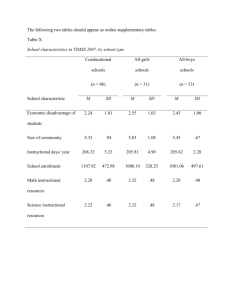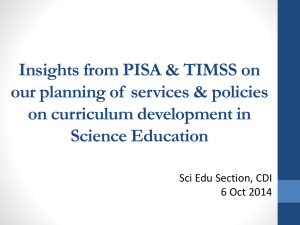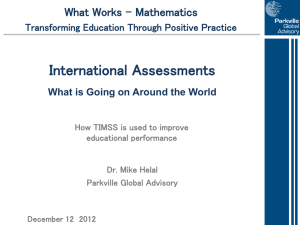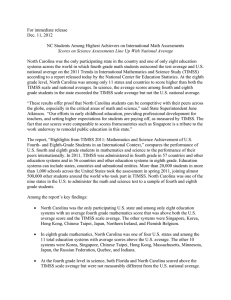Other information collected by TIMSS
advertisement
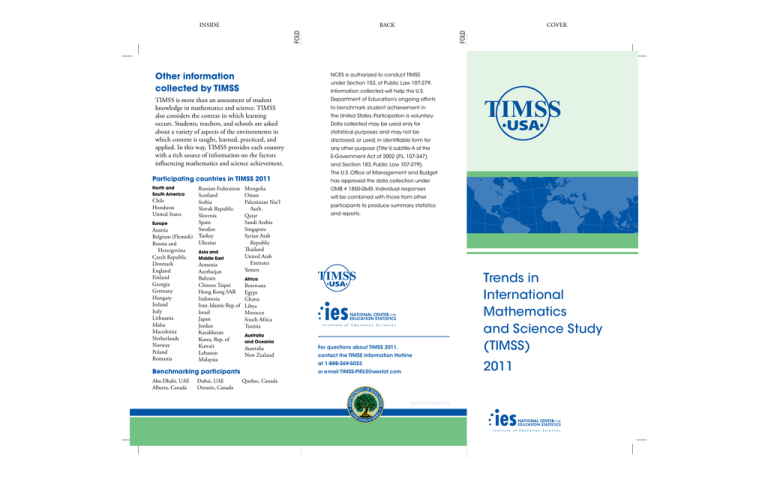
COVER fold BACK fold insidE Other information collected by TIMSS NCES is authorized to conduct TIMSS TiMss is more than an assessment of student knowledge in mathematics and science. TiMss also considers the context in which learning occurs. students, teachers, and schools are asked about a variety of aspects of the environments in which content is taught, learned, practiced, and applied. in this way, TiMss provides each country with a rich source of information on the factors influencing mathematics and science achievement. Department of Education’s ongoing efforts under Section 153, of Public Law 107-279. Information collected will help the U.S. Participating countries in TIMSS 2011 North and South America Russian Federation scotland Chile serbia Honduras slovak Republic United states slovenia spain Europe sweden Austria Belgium (Flemish) Turkey Ukraine Bosnia and Herzegovina Asia and Czech Republic Middle East denmark Armenia England Azerbaijan Finland Bahrain Georgia Chinese Taipei Germany Hong Kong sAR Hungary indonesia ireland iran, islamic Rep. of italy israel Lithuania Japan Malta Jordan Macedonia Kazakhstan netherlands Korea, Rep. of norway Kuwait Poland Lebanon Romania Malaysia Mongolia Oman Palestinian nat’l Auth. Qatar saudi Arabia singapore syrian Arab Republic Thailand United Arab Emirates Yemen dubai, UAE Ontario, Canada the United States. Participation is voluntary. Data collected may be used only for statistical purposes and may not be disclosed, or used, in identifiable form for any other purpose (Title V, subtitle A of the E-Government Act of 2002 (P.L. 107-347) and Section 183, Public Law 107-279). The U.S. Office of Management and Budget has approved the data collection under OMB # 1850-0645. Individual responses will be combined with those from other participants to produce summary statistics and reports. Africa Botswana Egypt Ghana Libya Morocco south Africa Tunisia Australia and Oceania Australia new Zealand For questions about TIMSS 2011, contact the TIMSS Information Hotline at 1-888-369-5033 Benchmarking participants Abu dhabi, UAE Alberta, Canada to benchmark student achievement in or email TIMSS-PIRLS@westat.com Quebec, Canada 28063.0510.86070305 Trends in International Mathematics and Science Study (TIMSS) 2011 What is TIMSS? The Trends in international Mathematics and science study (TiMss) is an international assessment and research project designed to measure trends in mathematics and science achievement at the fourth- and eighth-grade levels as well as school and teacher practices related to instruction. since 1995, TiMss has been administered every 4 years. TiMss 2011, the fifth study in the series, will involve students from more than 60 countries, including the United states. TiMss is sponsored by the international Association for the Evaluation of Educational Achievement (iEA) and managed in the United states by the national Center for Education statistics (nCEs), part of the U.s. department of Education. Why is TIMSS important? TiMss provides a unique opportunity to compare U.s. students’ math and science knowledge and skills at the fourth- and eighth-grade levels with that of their peers in countries around the world. TiMss complements what we learn from national assessments by identifying the strengths and weaknesses of student performance relative to students around the world. The results inform national discussions about education as well as international competitiveness. Key findings from TIMSS 2007 • In TIMSS 2007, the average U.S. 4thgrader’s mathematics score (529) was above the TIMSS scale average of 500 but below that of 4th-graders in 8 of the other 35 participating countries. The average U.S. 8th-graders’ mathematics score (508) was also TiMss provides valuable benchmark information on how U.s. students compare to students around the world, allows educators and policymakers to examine other educational systems for practices that could have application to the United states, and contributes to ongoing discussions of ways to improve the quality of education for all students. above the TIMSS scale average (500) but below that of 8th-graders in 5 of the other 47 participating countries. At both 4th and 8th grades, U.S. math scores in 2007 were higher than in 1995. •In science, the 2007 TIMSS average What type of assessment is TIMSS? The TiMss mathematics and science assessment is developed through an international consensusbuilding process involving input from U.s. and international experts in mathematics, science, and measurement. in a final step, the assessment is endorsed as suitable by all participating countries. The assessment contains a mix of questions: some require students to select appropriate responses, while others require that students solve problems and provide written answers. Examples of released TiMss items are available at http://nces.ed.gov/ timss/educators.asp. U.S. 4th-graders’ science score (539) was above the TIMSS scale average (500) but below that of 4th-graders in 4 of the other 35 participating countries. The average U.S. 8th-grader’s science score (520) was also above the TIMSS scale average (500) but below that of 8th-graders in 9 of the other 47 participating countries. At both 4th and 8th grade, U.S. science scores in 2007 were not measurably different than in 1995.
